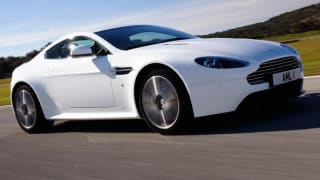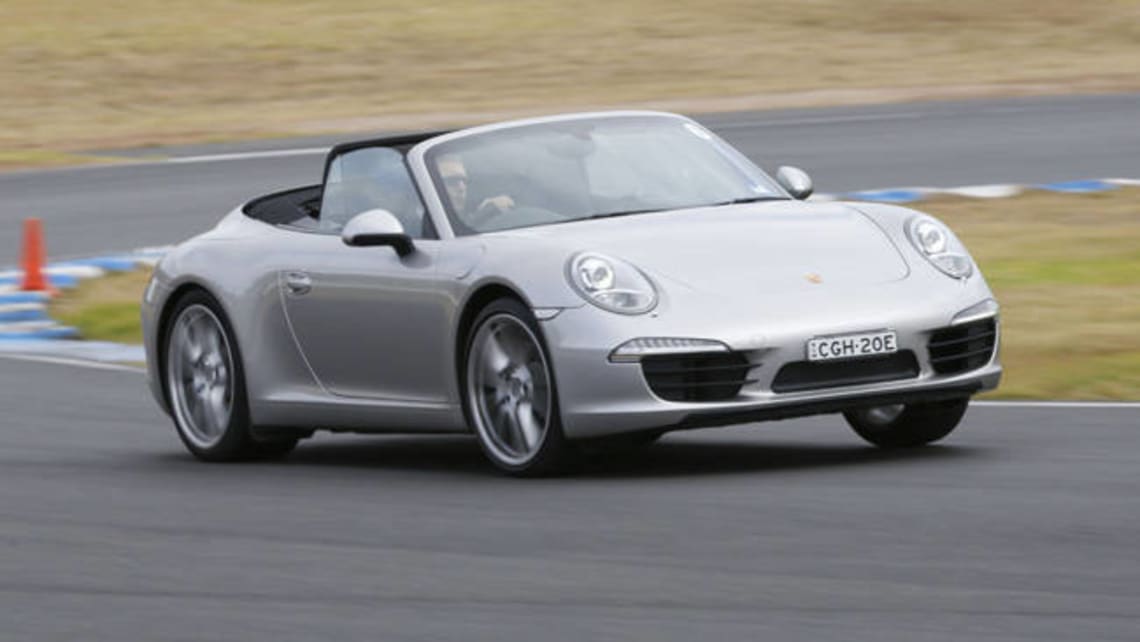
Aston Martin V8 2012 Review
Pine plantations, as the apparent preferred location for man's inhumanities, silently have...
Browse over 9,000 car reviews

Whenever I see a Porsche 911 Cabriolet, it's like visiting a stunning house and finding the carpet is purple shag pile. You can't help thinking, “Why did you do that? You were making all the right moves then veered off into weirdness.'' Perhaps it's about communing with nature, wind in your hair?
VALUE
Porsche's new 911 Carrera Coupes and Cabriolets have been on sale since late last year, although the cars available to sample so far have all been Carrera S Coupes with a 294kW 3.8-litre engine. The Cabriolet starts at $255,100 for the manual version and $294,250 for the S automatic plus on-road costs. The price premium is considerable too, at $25,000.

Strange, that convertible makers go to so much trouble, with wind-deflectors and other devices, to keep the flurries out. Most convertibles have heated seats, for a price, and some even offer neck-level warm-air blowers. Without them, you couldn't drive with the roof down in cold weather, and so you wouldn't do it all, because it's impossible when the Australian sun's shining.
TECHNOLOGY
This time the entire range was lined up, including a Coupe and Cabriolet with the new 3.4-litre entry-level engine. This is a version of the previous 3.6-litre unit with a shorter stroke. Like the 3.8, it adopts a suite of fuel-saving strategies, such as clever thermal management and an idle-stop system. As a result, fuel consumption is down by at least 12 per cent, with every car in the range below 10 litres per 100km.
As with the 3.8, maximum outputs in the 3.4 are reached higher in the rev range compared with the engine it replaces. Peak power arrives 900rpm higher, at 7400rpm, while peak torque is achieved with an extra 1200rpm, at 5600rpm. However, neither engine has lost its driveability, with the same low-rev torque available from just off idle. In the 3.4, that means around 300Nm from get-go. It's a flexible as ever.
The Coupe and Cabriolet share engineering, with the same transmission options of Porsche's seven-speed manual or dual-clutch automatic, increased wheelbase and focus on shedding weight through greater use of aluminium.
DESIGN
The Cabriolet is on average more than 50kg lighter than its predecessor and 18 per cent more rigid, with a redesigned rollover protection system behind the cabin helping to add stiffness to the body. Nevertheless, the Cabriolet is unavoidably heavier than the equivalent Coupe by a substantial 85kg.
Its key advance this time is a redesigned folding roof. It uses magnesium panels to smooth its contours and the result is a cabin silhouette that can match the coupe to the millimetre, Porsche says. The flush-fitting glass window helps to make it impressively smooth, without the obvious framework that usually spoils the outline of a fabric roof. Invaluably, it can be operated on the move up to 50km/h, opening or closing in just 13 seconds.
The Cabrio also feels tightly put together and very solid for an open-roof car. The roof stashes neatly behind the cabin and over the rear axle, and there's no sense of panels shifting slightly that you get with some solid folding tops. So if you are going to buy a convertible, here's one that sits at the top of the class.
But there's no avoiding the compromises. The Cabrio cannot be as rigid as the Coupe and the extra weight cannot be wished away. The killer compromise for me, though, is that despite its cleverness the roof needs a raised “hump'' behind the cabin to fold into. This spoils the shape. Your bum really does look big in this.
DRIVING
The convertible is two-tenths slower than the hard-top for any given engine-transmission combination. All of which makes the Coupe a no-brainer for two-thirds of Australian buyers, while the rest will find the lure of the Cabriolet harder to resist than ever. As usual, Porsche has tried to minimise the disadvantages of the Cabrio and make it as close to the Coupe as possible.
The 3.4 isn't as quick as the 3.8, but you don't feel short-changed. The slowest Cabriolet 3.4 manual can reach 100km/h in 5.0 seconds and the quickest, the Cabriolet S automatic with launch control, in 4.3s. Sounds terrific, too.
From the inside, roof up, the magnesium shell makes it seem almost as solid as a normal roof. It represents an effective compromise between traditional fabric and the folding hardtops favoured by some premium makers. It works with a single button-press and an adjacent switch raises the new wind deflector. On the track, roof down, it proved remarkably effective at keeping the wind out even on the straight, with speeds well in excess of 200km/h.
Why get the convertible when there's a perfectly good version with a roof? The coupe is quicker, handles better and has the classic shape. The Cabriolet spoils everything. It's heavier, shakier and needs a humpback to pack the roof, spoiling the coupe's beautiful lines. So if it was my garage, there's no way I'd be tempted from the hardtop. But some will. They've already measured up the den for 1970s retro rugs.
VERDICT
It's a classy convertible, but a puzzling choice if you're after a 911.
| Vehicle | Specs | Price* | |
|---|---|---|---|
| GT3 RS 4.0 | 4.0L, PULP, 6 SP MAN | No recent listings | 2012 Porsche 911 2012 GT3 RS 4.0 Pricing and Specs |
| GT3 | 3.8L, PULP, 6 SP MAN | No recent listings | 2012 Porsche 911 2012 GT3 Pricing and Specs |
| GT3 RS | 3.8L, PULP, 6 SP MAN | No recent listings | 2012 Porsche 911 2012 GT3 RS Pricing and Specs |
| Carrera Black Edition | 3.6L, PULP, 7 SP AUTO | $64,900 – 74,580 | 2012 Porsche 911 2012 Carrera Black Edition Pricing and Specs |
$134,990
Lowest price, based on 4 car listings in the last 6 months